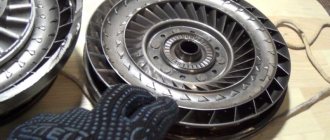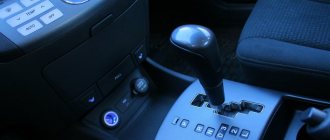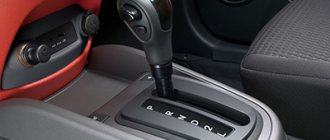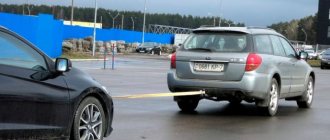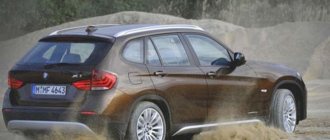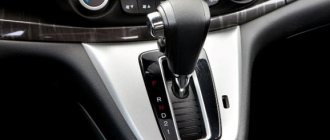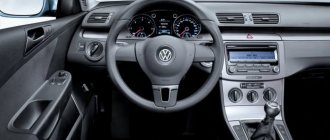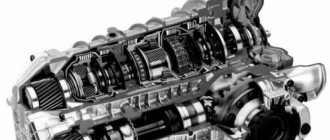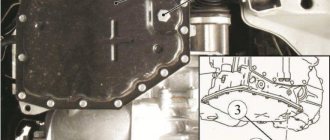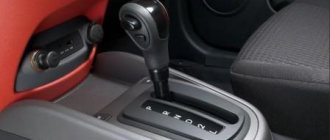Every year the number of motorists preferring cars with automatic transmission is growing. Driving a car like this is much easier. However, you should not start driving an automatic car without knowing the main nuances and features. After all, incorrect operation of the “automatic” can not only lead to breakdowns of an expensive automatic transmission, but also provoke an emergency situation on the road. Incorrect operation of a manual transmission can lead, in the worst case scenario, to replacing the clutch, but errors in operating an automatic transmission can cost a pretty penny, because the entire mechanism will have to be replaced, and this is not a cheap pleasure. In this regard, if you do not yet have experience driving a car with an automatic transmission, then you should resort to outside help and take driving lessons in a car with an automatic transmission, or watch video lessons on the Internet or read how to use automatic transmission and about the main nuances of driving a car with a similar gearbox.
What do the letters on the box mean?
Decoding the designations for the position of the selector handle on the automatic transmission
Before you start driving, you need to familiarize yourself with the automatic transmission gear selector, the symbols on it and understand how to operate the automatic transmission. Traditionally, the main modes found on the machine are:
- P – parking mode. When the sector is switched to parking mode, the drive wheels are blocked. It is used if it is necessary to park on an uneven or slightly sloping surface;
- R – automatic reverse;
- N – “neutral” or neutral gear. While driving, it is better not to use it and use it only if it is necessary to move with the engine running over short distances, at a car service center, for example;
- D – main mode. By turning on the above mode, you can drive at any convenient speed;
- 2 – driving mode in the first two gears. It is most convenient to use it when driving at low speeds, up to 80 km/h, for example, on difficult sections of the highway or when towing;
- L – driving mode at first speed. It is used if the speed does not exceed 15 km/h, for example, on a section of a dirt, washed-out road.
In some models, the standard package of box modes can be supplemented with several more. Additional modes found on cars with automatic transmission:
- O/D or OverDrive – fast acceleration mode, which is used when overtaking other vehicles or during long climbs;
- Kick-Down is a mode of shifting down 1-2 gears, providing acceleration. Kick-Down on an automatic machine should not be used if the car has not yet reached a speed of 20 km/h;
- RWR Sport – fast acceleration mode, accompanied by high fuel consumption. It is usually used for driving on autobahns;
- Snow is a special mode designed for winter driving. When driving in the above-mentioned mode, movement starts from 2nd speed, which significantly reduces the possibility of slipping and spinning in place of the drive wheels.
Where to take automatic driving lessons in Moscow with an instructor
Our educational center offers automatic driving lessons in Moscow: we will teach how to use automatic transmissions for beginners and experienced drivers who are accustomed to mechanics.
The training course consists of two parts – theoretical and practical. First, cadets study the structure of cars with automatic gear shifting, master the principle of operation, and train on a driving simulator. At the same time, they learn the rules of the road, the meaning of signs, and how to provide medical assistance in case of an accident. Then they practice the acquired skills on the racing track.
After this, together with the instructor, they go out onto the streets of the capital - along educational directions and routes similar to exam ones. A driving instructor will help you work through such maneuvers as braking, reversing, parking, starting a tow, using the handbrake, etc.
Training time usually does not exceed 2.5 months. If you are over 17 years old, you can sign up for automatic driving lessons at our driving school by phone or by submitting an online application. Experienced teachers will tell you all the nuances of such driving, and you will pass the traffic police license test without any problems.
One of our many branches, Krylatskoe Driving School, will be happy to offer you a full driving course.
The location of the pedals on a car with an automatic transmission
The location of the pedals in a car with an automatic transmission
Is it possible to tow another car with an automatic transmission? You can read here
Another point that you should pay attention to before analyzing the features of driving a car with an automatic transmission is the location of the pedals. In cars equipped with an automatic transmission, there are only two pedals - gas and brake. The usual “clutch” pedal for mechanics is absent, but this does not mean that the car has no clutch at all. Simply, the automatic transmission does not have dry discs responsible for opening the gears. This function is performed automatically by moving transmission oil. Only one leg is involved in driving, which is very unusual for mechanical enthusiasts. But over time, you will get used to it and you will understand how convenient it is.
Useful links:
- "Tips for novice drivers"
- “Ten basic rules for safe driving in a modern city”
- “How to quickly get a license: buy, study, conditions. Advice from the director of a driving school"
Tweet
Call us and get a free consultation!
+7 (495) 122-00-15
Or fill out an application to enroll in a driving school and the administrator will definitely call you back:
How to drive a car with automatic transmission
Having examined the main points related to the selector and pedals, you can begin to study issues directly related to driving. As in the case of mechanics, first of all, start the engine and warm up the car, focusing on the time of year and temperature, warm up the engine for 2 to 10 minutes. It is recommended to start the engine by switching the lever to N or P mode, and it is better to give preference to the parking mode.
It is recommended to start the engine in N or P modes, and it is better to give preference to the parking mode.
When the car has warmed up, all that remains is to move off. To start moving, just depress the brake pedal and switch the variator to one of the driving modes D - for driving in a forward direction or R - for moving in reverse. To move under normal conditions, the most optimal mode is mode D. Based on the condition of the road surface, weather conditions and some other factors, you have the opportunity to adjust your movement by selecting a special mode. The car has started and is moving normally along the highway; at a certain moment you will need to stop and park. So, how do you brake with an automatic transmission? Like all control in general, the braking process is a relatively simple task. The braking process consists of carefully and smoothly squeezing the brake pedal; you must press it until the car comes to a complete stop. If the stop is not long, at a traffic light, for example, then the selector modes can not be touched.
Read also: Mazda cx 5 white mother of pearl
In order to remove the car from the handbrake and move off, you need to switch to mode D and, while holding the brake pedal, remove the car from the handbrake.
And in cases where you intend to stop the car for a certain period of time and leave, then first you should squeeze the “brake” and without releasing the pedal, put the car on the handbrake and turn on the P mode. When parking on surfaces without slopes, or on surfaces with a slight slope, you can do without a handbrake. In order to remove the handbrake and move off, you need to switch the selector to mode D and, while holding the brake pedal, switch the car from the handbrake. Several important rules, the observance of which, when operating a car equipped with an automatic transmission, will help avoid unwanted breakdowns:
- You cannot turn on the parking mode while driving, that is, until you come to a complete stop - this can lead to the transmission being damaged;
- if you move the selector to position R without waiting for it to stop, this will cause problems not only with the gearbox, but can even damage the engine;
- You should not use neutral while driving;
Try to avoid towing. It’s better not to tempt fate and call a tow truck.
If you take all these points into account and watch a couple of video lessons about driving a car with an automatic transmission for beginners, you will soon not only easily drive your car, but also get real pleasure from the driving itself.
Driving a car equipped with an automatic transmission is quite simple; difficulties arise for beginners who are not familiar with the operating principle of the automatic transmission and its design features.
Start driving a car in automatic transmission
Before you start the trip, you need to take a comfortable position in the seat, check the rear view mirror, as well as the interior mirror, then you need to start the engine.
You need to select the parking position, turn the key one hundred and eighty degrees clockwise, then you need to wait three seconds, and then turn the key all the way.
After this, you need to select mode D (drive), that’s it - the car is already in motion.
A little theory
Have you driven a car with a manual transmission and are not a “dummies”? Then, at first, when driving an automatic transmission, watch the position of your left foot. The acquired habit of pressing the clutch pedal, which is absent on cars equipped with an automatic transmission, can interfere with driving. Obviously: before driving a car equipped with a selector, learn to use only one foot - quickly move your right foot from the gas pedal to the brake, without remembering the clutch.
The gear shift lever in cars equipped with an automatic transmission is called a selector; it is additionally equipped with a release button that prevents incorrect gear shifting. The main advantage of this type of gearbox is the ability to electronically select a gear ratio that corresponds to driving conditions, without driver participation. There is no need to learn to shift gears smoothly: the “smart” gearbox copes with this task on its own.
Driving a car equipped with an automatic transmission begins with studying the basic operating modes of the unit, which have the appropriate designations:
- “P” - parking, used to start the engine. The selector switches to this position when the vehicle is completely stopped or when using the handbrake. Some manufacturers of cars with automatic transmissions indicate in the vehicle operating instructions the need to use the handbrake when using the “Parking” position.
- "D" - forward movement, allows the car to move forward. Depending on the degree of pressing of the gas pedal and the driving conditions of the vehicle, the gears will be selected automatically. While in this mode, the machine standing on an inclined surface will not roll back if the angle of the surface is not too steep.
- "R" - reverse, allows the car to move backwards. This position is activated after the car has come to a complete stop, plus when the brake pedal is depressed.
- “N” - neutral, used to warm up the engine in the cold season; it is not recommended to switch the selector to the indicated position while the car is moving. Ensures idle operation of the power unit without transmitting torque to the wheels.
- “D2” (or S) - downshift, used on descents and ascents. Stopping the car in this mode will be more effective than in position “D”. The box will use only two gears - first and second.
- “D1” (or L) is the subsequent gear reduction range, used when roads are icy, mountain serpentines, and in some cases can be used for engine braking. In this mode, the car will always move in first gear.
Switching the selector from position “D” to position “D3” (D2), “D2” (D1) is performed while the machine is moving. Improved automatic gearboxes have additional acceleration modes:
Read also: Deprivation of a special rank of a police officer
We recommend that “dummies” watch a video about driving a car with an automatic transmission for beginners:
Practical lessons
Set the selector to the required mode by following these steps:
- Start the engine (you can only switch the lever when the engine is running).
- Depress the brake pedal.
- Press the desired mode button located on the selector (if necessary).
- Select a position that corresponds to the desired direction of movement of the machine: “D” - the vehicle will go forward, “N” - neutral, the machine will stand still or roll downhill, “R” - it will go backward. When the driver selects the gear, the car will not start moving, but when you release the brake pedal, the car will move. Take this nuance into account; do not remove your foot from the “brake” ahead of time to avoid an accident.
Automatic transmissions recognize the driver's commands by pressing the gas pedal: smooth acceleration, gradual gear shifting is ensured by pressing with little force. Intense acceleration, required when overtaking, is achieved by pressing the gas pedal to the floor, while the automatic transmission will first shift into a lower gear, then the car will begin to accelerate. Please note: from the moment you press the gas pedal until the vehicle accelerates, there is a slight delay, about one second; this time is imperceptible when driving slowly, and can be fatal in overtaking conditions.
When you decide to stop the car, press the brake pedal. When making a short stop at a traffic light, do not move the selector from position “D” - extend the life of the internal mechanisms of the automatic transmission.
Keep the brake pedal depressed after stopping the car in the following situations:
- During long stops (traffic jams), pressing the brake pedal will allow the engine to rest, so fuel will not be burned in vain, use the “N” position.
- The car is parked on a slope, the selector lever is not in the “P” position.
The above instructions for dummies will allow you to drive a car with an automatic transmission. Please note: it is better to immediately learn how to drive correctly so as not to damage the automatic transmission. Correcting bad driving habits is difficult.
Features of parking and reversing
How can a woman learn to drive? Learn the features of parking and reversing! After all, it is with parking that many women have serious problems. For some, it's a nightmare where every turn of the wheel does the opposite of what is expected.
How to easily and quickly park in reverse:
- Find an empty seat. For your first attempts, it is better to find an empty parking lot.
- Drive so that the rear bumper of the car is slightly ahead of this place.
- Notify other drivers of your intention to stand in this place by turning on your turn signal.
- Before engaging reverse gear, check for oncoming vehicles ahead and approaching vehicles behind. Check the rear view and side mirrors for pedestrians. This is a very important safety precaution, especially when parking in a public place.
- Engage reverse. Turn the steering wheel to the right when the car slowly begins to accelerate in reverse.
- Continue to drive backwards and straighten the vehicle's steering wheel as it enters a parking space.
- Check the left and right mirrors to avoid hitting other cars.
- Once the vehicle is level in the parking space, straighten the steering wheel and position yourself in the parking space until the front of the vehicle is level with the front of the other vehicles in that row.
- Make sure that you are able to drive far enough into the parking space so that the front of the car does not block the passage.
There is nothing difficult about parking in reverse, you need to practice and remember to look in the mirrors. By the way, any shocking parking antics can be corrected through regular practice.
It is important to note that how many hours it takes to learn to drive depends on each individual. It should be remembered that practice makes perfect. This also applies to driving. You can't expect to become a good driver if you only drive once every couple of months. You need to drive as much as possible. When it comes to driving tips, this is the deciding factor. And, most importantly, women can be excellent drivers if you find a competent instructor and choose a good driving school. Additionally, there are many women who are much better drivers than men.
Additional modes
Additional modes of automatic transmissions include:
- Winter mode is designated “*”, “W”, “SNOW”, “HOLD”, “WINTER”. According to it, slipping is eliminated when changing gears and when the vehicle starts moving. The car starts moving from second gear. Switching to other gears occurs at lower drive speeds - this eliminates fluctuations in the operation of the gearbox during acceleration and reduces the likelihood of the car skidding. Experts clarify: you should not use this mode in the summer - you can get the box overheated due to reaching the maximum load on the unit.
- The "D" position submodes limit acceleration above a certain gear range:
- “S” or “Z” - ensuring that the gear is not higher than third. These positions are used on sections of the road that require increased attention from the driver. When driving, use the “Z” mode, while monitoring the tachometer readings; its needle should not fall into the red zone.
- “2” - restriction of gear engagement no higher than second, the vehicle moves at a speed of no more than 80 km/h. Used on steep slopes and slippery roads.
- “1”, “L” - used for severe operating conditions of the machine: off-road driving, steep slopes. Transmission only, speed no more than 40 km/h.
Additional operating modes for automatic transmissions allow you to control the machine under unfavorable conditions. Please note: accidental activation of sub-modes “1”, “2” at high speed will lead to a sharp slowdown in the vehicle’s movement and will cause the vehicle to skid.
General recommendations
An inexperienced driver can operate an automatic transmission; the recommendations below will extend the life of the automatic transmission:
- You cannot put heavy loads on an unheated box. Transmission oil warms up more slowly than engine fluid. When driving a car with the specified type of gearbox, drive several kilometers at low speed.
- Avoid wheel slipping: do not press the gas sharply if the road surface is uneven.
- Try not to tow trailers or other cars.
- Avoid switching to neutral when the vehicle is moving.
Proper operation of an automatic transmission allows you to enjoy driving and prevents premature breakdown of the unit, allowing the mechanism to function normally.
Currently, more and more cars are coming off the assembly line equipped with an automatic transmission. The thing is that in city mode with traffic jams and constant stops at traffic lights, an automatic transmission is very convenient, saving a lot of nerves and time for the driver.
In this article, we will analyze in detail all the intricacies of operating a car with an automatic transmission: how to start the vehicle, how to get started correctly, and what you should never do.
Lock as a precaution when driving an automatic car
Driving an automatic for beginners requires careful attention to the vehicle's driving modes. Thus, you should remember a few simple rules:
- The automatic transmission lever is designed with some safety measures. If the automatic transmission lever switches to certain modes without pressing the lock button, this means that the lever can be moved into these ranges both when the car is moving and when starting off.
- If the lever is moved to a certain mode only by pressing a button on the selector, then this indicates that some precautions must be taken to perform this action.
Thus, with the selected driving mode “1”, you can safely move the lever to position “2”, and then switch it to the “3” or “D” range on the move, without stopping your vehicle. However, it is worth noting that switching the lever from the “Third” position to the “Second” or “First” is already accompanied by pressing the latch. This is done to prevent damage to the box if the driving mode is incorrectly selected. Otherwise, the machine will be subjected to significant overloads, which will inevitably lead to its breakdown.
Therefore, to correctly switch between modes in this order, it is necessary to either stop completely or slow down the speed of the vehicle. Thus, switching the lever from position “Three” to “Second” gear without using a locking button is impossible; compliance with restrictions and subtleties is required. Namely, you cannot use such a combination when driving above a speed of 70 km/h, so as not to damage the transmission. Although in new automatic transmission models this nuance seems to have been removed, so switching when driving even at high speeds will not bring much harm, even if the switch is incorrect.
That's all we wanted to say on this issue. Driving an automatic transmission for novice drivers causes difficulties only at first, which cannot be said about a manual transmission. First you need to understand the modes of your transmission. In any case, all the necessary recommendations for using the automatic transmission capabilities of a specific car model are available in the service documentation. Such documents usually “come” with the car upon purchase, or can be found by make and body number on the Internet.
New articles
- How to brake correctly in a car with a manual transmission? Types of braking for beginners
What is an automatic transmission
An automatic transmission is one of the types of transmission in which the required gear ratio is automatically selected without driver intervention, taking into account the nature of the movement, speed and other parameters.
In a car with an automatic transmission, there is no clutch pedal due to the fact that the clutch is replaced by a torque converter, which transmits torque to the wheels.
Starting a car with automatic transmission
To ensure the safety of the automatic transmission, several types of protection are provided in the car.
To start the car engine, the selector lever must be in the Parking (P) or N eutral (N) position. When the selector is in other modes, starting the engine will be impossible, since either the key will not turn or nothing will happen at all.
Read also: Coolant circulation diagram
Due to the fact that the “N” mode is intended by the manufacturer mainly for towing the car, it is preferable to use the “P” mode to start the engine, in which the drive wheels are locked, which protects against unplanned movement of the vehicle on an inclined surface.
Another important protection against improper starting of the car is the need to depress the brake pedal, which is very useful when starting the car in the selector position on “N”, since the pressed brake pedal will prevent the car from rolling when it is on an inclined surface.
Modern cars have additional types of protection to prevent theft. If, despite following all the steps to start the engine correctly, the key in the ignition switch cannot be turned and the steering wheel also does not respond to attempts to turn it, the anti-theft protection has turned on.
To remove it, you must carefully turn the key while turning the steering wheel in any direction. With coordinated actions, the theft protection will turn off and the car will be able to start.
How to start automatically
After starting the engine, the car must be released from the handbrake.
To start driving with the brake pedal depressed, you must move the selector to one of the positions by pressing the button on it:
- “D” - forward movement under normal conditions;
- “R” - reversing if maneuver is necessary;
- “L” or “D2” - for off-road driving, when the car is on a significant slope at the moment it starts moving, the maximum permitted speed for such modes is less than 40 km/h;
- “D3” - if necessary, move down a small hill;
- “S”, “W”, “*”, “Hold”, “Winter” - winter mode, for starting and driving on snow with a reduced probability of slipping of the drive wheels.
After releasing the brake pedal, the car will begin to move even without pressing the accelerator (gas) pedal.
In severe frosts, before driving after a long period of parking in a cold place, it is necessary to allow the engine and transmission to warm up for 6-10 minutes.
How to brake with an automatic engine
With automatic transmissions, you can use engine braking, but this process differs from manual transmissions.
To apply engine braking, depending on the conditions, you must select the following selector positions:
- if there is an “O/D” button at a speed below 110 km/h, it can be pressed to smoothly brake the engine and limit the speed to 80 km/h;
- “L”, “D1” or “D2” when driving off-road with descents and ascents at a large angle, these modes allow you to use maximum power and limit the speed to 20-50 km/h (L, D1), 40-80 km/h h(D2);
- “D3” - movement up to 3rd gear at speeds up to 100-110 km/h;
How to use the handbrake
The manufacturer indicates that it is necessary to use the parking brake even in the selector position “P”
The main points for using the handbrake are:
- the need for additional securing of the car when parked with the engine running, especially when leaving the vehicle;
- the need to securely secure the vehicle in case of installing a spare wheel and other minor repairs;
- when stopping on a surface with a large inclination angle to avoid the selector being knocked out of the “P” position due to the heavy load on the drive wheels.
Before starting to drive, it is necessary to check the parking brake to avoid trying to start driving with the parking brake applied.
Brake pedal
Since a car equipped with an automatic transmission does not have a clutch pedal (it turns on automatically when the required engine torque is reached), movement begins after the brake pedal is released.
Factory engine settings allow you to start moving even without pressing the gas pedal after releasing the brake pedal. Gas is added to move to a higher transmission stage.
Brake pedal
The brake pedal also regulates the speed limit when driving on roads during coasting descents from hills. In position P (parking), the hand brake does not need to be applied, since the wheel drive is in rigid coupling with the gears of the automatic transmission, and a very large external force is required for the car to move.
